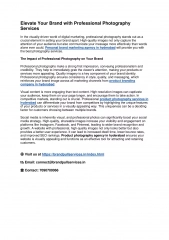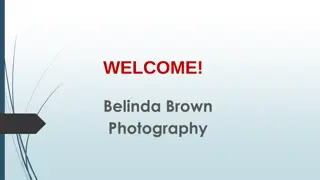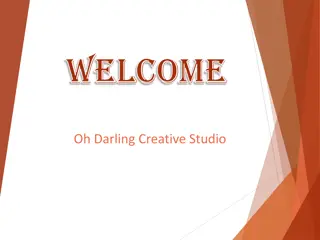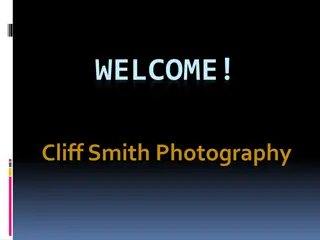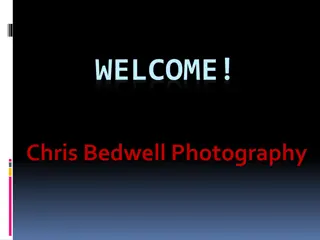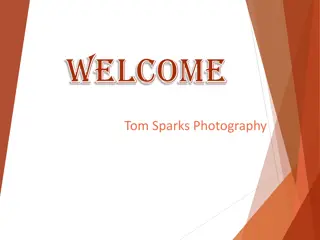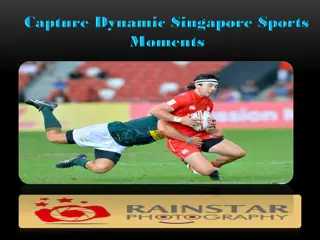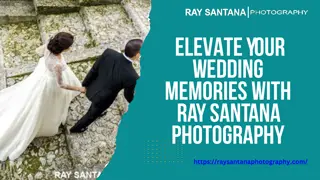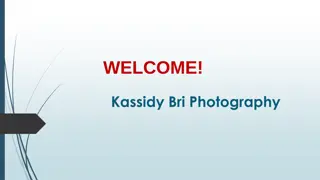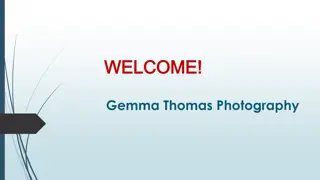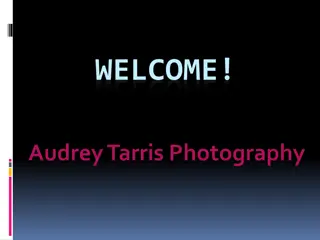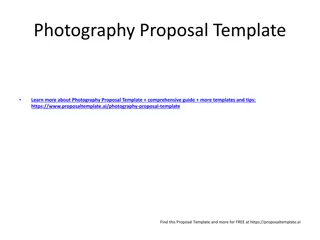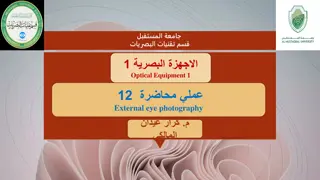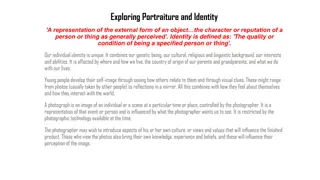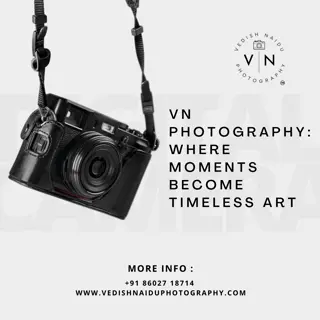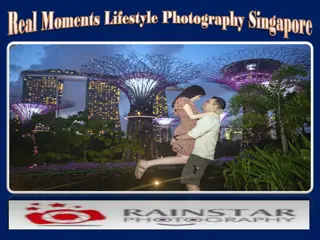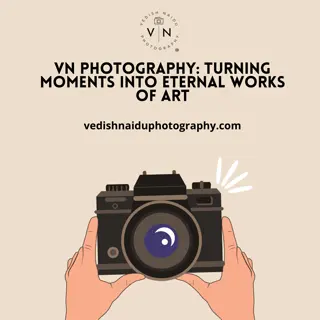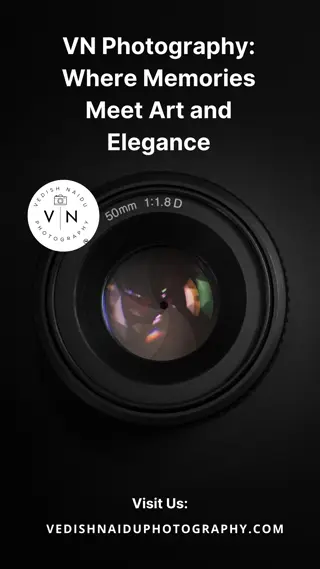Exploring Different Styles of Portraiture in Photography
Portraiture in photography captures the essence of a person or group, conveying their expression, personality, and mood. Traditional, environmental, and candid styles offer unique perspectives. Traditional focuses on the face as the primary element, while environmental showcases subjects in their natural setting. Candid captures unposed moments, ideal for photojournalism and event photography.
Download Presentation

Please find below an Image/Link to download the presentation.
The content on the website is provided AS IS for your information and personal use only. It may not be sold, licensed, or shared on other websites without obtaining consent from the author. Download presentation by click this link. If you encounter any issues during the download, it is possible that the publisher has removed the file from their server.
E N D
Presentation Transcript
OUTLINE Unit 2: OCR Externally Set Task Unit 1: Portfolio 10 Hour Supervised Task 45 Hour to Complete Portfolio 80 Marks 120 Marks 40% of Qualification 60 % of Qualification 40% Candidates need to Produce a portfolio of work for this unit that demonstrates a personal response to a starting point. For this unit OCR will give students a choice of starting points in the form of written and/or visual starting points 60%
OUTLINE Unit 2: OCR Externally Set Task Unit 1: Portfolio 10 Hour Supervised Task 45 Hour to Complete Portfolio 80 Marks 120 Marks 40% of Qualification 60 % of Qualification 40% Candidates need to Produce a portfolio of work for this unit that demonstrates a personal response to a starting point. For this unit OCR will give students a choice of starting points in the form of written and/or visual starting points 60%
COURSEWORK PROJECT PORTRAITURE
PORTRAITURE Portrait photography or portraiture is photography of a person or group of people that displays the expression, personality, and mood of the subject. Like other types of portraiture, the focus of the photograph is usually the person s face, although the entre body and the background or context may be included. photography of people can be broken down into numerous categories. It is important for photographers to identify separate styles in order to choose the right creative direction for projects.
TRADITIONAL TRADITIONAL OR CLASSICAL PORTRAITURE WOULD REFER TO AN IMAGE WHERE FACE IS THE PREDOMINANT ELEMENT. THE PURPOSE OF THE PHOTOGRAPH IS TO DEPICT VISUAL REPRESENTATION OF THAT PERSON. SUBJECT IS EXPECTED TO BE LOOKING DIRECTLY AT THE CAMERA. WITH WHAT IS DESCRIBED AS A HEAD-SHOT, TWO THIRDS OR FULL BODY FRAMING CAN BE USED
ENVIRONMENTAL THE TERM ENVIRONMENTAL PORTRAIT REFERS TO AN IMAGE WHERE THE SUBJECT IS PHOTOGRAPHED IN PERSON S NATURAL ENVIRONMENT. FOR EXAMPLE, A WORKER PHOTOGRAPHED AT THE CONSTRUCTION ZONE, TEACHER IN THE CLASSROOM, SCULPTOR IN A SCULPTURE STUDIO AND SO ON. SURROUNDINGS ARE USED TO COMPLIMENT THE SUBJECT AND TO EMPHASIZE HIS CHARACTER. SUBJECT AND SETTING ARE CHOSEN BY THE PHOTOGRAPHER.
CANDID A CANDID PORTRAIT IS TAKEN WITHOUT A SUBJECT EXPECTING OR ACKNOWLEDGING THE PHOTOGRAPHER. THIS STYLE USED IN PHOTO JOURNALISM,TRAVEL PHOTOGRAPHY,STREET PHOTOGRAPHYANDEVENT PHOTOGRAPHY. AS OPPOSED TO AN ENVIRONMENTAL PORTRAIT THIS IMAGE IS CAPTURED AT THE MOMENT RATHER THAN SET UP.
GLAMOUR THE TERM GLAMOR PORTRAIT REFERS TO PORTRAITS WHERE EMPHASIS IS GIVEN TO HIGHLIGHT THE SEXY ROMANTIC APPEAL OF THE SUBJECT.
LIFESTYLE THE TERM LIFESTYLE PORTRAIT REFERS TO PORTRAITS WHERE EMPHASIS IS GIVEN TO SUGGEST THE STYLE OF LIVING OF THE INDIVIDUALS DEPICTED. TECHNICALLY IT IS A COMBINATION OF ENVIRONMENTAL PORTRAIT AND CANDID PORTRAIT. MORE WEIGHT IS GIVEN TO COMMUNICATE THE FEELING OF LIFE EXPERIENCE OF THE SUBJECT. STYLE HAS NUMEROUS IMPLICATIONS IN COMMERCIAL AND FINE ART PHOTOGRAPHY. EDITORIAL, FASHION, PHARMACEUTICAL, AND FOOD INDUSTRIES OFTEN USE LIFESTYLE IMAGES TO EVOKE EMOTIONS IN VIEWERS BY DEPICTION OF DESIRED LIFE STYLES. IT IS COMMON TO SEE THIS STYLE USED IN WEDDING AND FAMILY PORTRAIT PHOTOGRAPHY AS WELL.
SURREAL SURREAL PORTRAITS ARE CREATED TO EMPHASIZE THE OTHER REALITY. A DEPICTION OF A PERSON S INTERPRETED SUBCONSCIOUS MIND. SURREALISM IS AN ART MOVEMENT STARTED IN THE EARLY 1920 S AND STILL ALIVE AND WELL. IN PHOTOGRAPHY TRICKS AND SPECIAL EFFECTS ARE USED TO ACHIEVE A SURREAL LOOK.
CONCEPTUAL CONCEPTUAL PORTRAIT REFERS TO IMAGES WHERE CONCEPT ADDS A FOURTH DIMENSION. THE HIDDEN MEANING OF THE CONCEPT WILL LEAVE THE VIEWER GUESSING AS IT IS OFTEN OPEN FOR INTERPRETATION. CONCEPTUAL ARTISTS GENERALLY GET OFFENDED WHEN ASKED WHAT DID THEY MEAN IN THEIR PHOTOGRAPH. IT IS THE JOB OF THE VIEWER TO DECIDE. CONCEPTUAL PORTRAITS ARE OFTEN USED IN ADVERTISING PHOTOGRAPHY BUT CONCEPTS ARE MUCH EASIER TO UNDERSTAND.
ABSTRACT ABSTRACT PORTRAITS ARE CREATED WITH A PURPOSE OF CREATING ART AND NOT BASED ON REALISTIC REPRESENTATION OF A PERSON. COLLAGE OR DIGITAL MANIPULATION IS OFTEN USED.
NAME GCSE PHOTOGRAPHY COURSEWORK: PORTRAITURE INSPIRATION IMAGES BACKGROUND INITIAL IDEAS
THE FUNDAMENTAL STYLES OF PORTRAITURE A CLEAR EXAMPLE OF EACH STYLE OF PORTRAITURE AND A SMALL PASSAGE OF INFORMATION Traditional Traditional Traditional Environmental Environmental Environmental 4 5 6+ Candid Candid Candid Conceptual Conceptual Conceptual Lifestyle Lifestyle Lifestyle Glamour Glamour Glamour Abstract Abstract Abstract Surreal Surreal Surreal
PAGES TO COMPLETE COVER PAGE 8 STYLES OF PORTRAITURE
INSPIRATION PAGE SELECT 1 OF THE 8 FUNDAMENTALS STYLES OF PORTRAITURE THAT YOU WANT TO EXPLORE RESEARCH CLEAR AND OBVIOUS EXAMPLES OF THIS STYLE OF PORTRAITURE TRADITIONAL ENVIRONMENTAL COLLECT 15/20 HIGH QUALITY IMAGES FOR YOUR INSPIRATION PAGE 4 CANDID INFORMATION ABOUT THE STYLE OF PORTRAITURE CONCEPTUAL WHY YOU CHOSE THAT STYLE LIFESTYLE 5 GLAMOUR 6+ BRIEFLY DISCUSS THE WORK OF KEY PHOTOGRAPHERS THAT HAVE ABSTRACT 6+ INFLUENCED YOUR DECISION AND INSPIRED YOUR IDEAS. SURREAL
COVER PAGE 8 STYLES OF PORTRAITURE INSPIRATION PAGE
ARTIST: ADNREY ARTIST: ADNREY TITLE: CORE TITLE: CORE DATE: 2007 DATE: 2007
context context The piece, entitled Core was created by Adnrey in 2007. The artist Adnrey is a contemporary digital artist and illustrator whose work typically explores a darker, surreal reality to portraiture. Characteristically his work combines the styles of surrealism with conceptual; art in which the idea or concept presented by the artist is considered as important as the final outcome.
ContentThe piece, Core shows a hollow portrait occupied by a dolls when regarded as concealed in adulthood. Content head. I believe the most important element within this piece is the portrait of the doll because this, I feel, is responsible for conveying the concept of this piece. The original photograph, prior to editing, I believe to be a staged event taken within a studio space. The image has been heavily manipulated using a program similar to, if not Photoshop. In my opinion the theme of the work centres on the notion of an internal identity, the concept of an inner child. A person's supposed original or true self, especially
The type of lighting used, given its suspected studio location, looks to be artificial. However, due to the substantial amount of editing it is difficult ascertain the direction and placemen of lighting. The choice of lighting has little impact on the photograph, showing relatively medium tones with little highlight. In support of the photographs studio location an ISO of 100 can be assumed, keeping noise to a minimum. The photograph adopts a narrow depth of field, between f/5.6 and f/8. This can be presumed from the nature of the photograph, portraiture. This aperture value is ideal for creating a blur background, keeping only the subject focus, creating a sense of separation from the background. Given the subject matter it is important to consider the focal length of the piece. It can be assumed that the selected focal length lies between 85mm and 135mm, this assumption is based on the subject being a portrait. Support for this theory comes from the lack of distortion in the portrait, making portraits share caricature qualities. The portrait is clean and sharp and therefore provides clear evidence for a quick shutter speed being adopted. The common rule being that the shutter speed should match or exceed the focal length means a value of 1/85sec. 1/135sec. or greater. process process
The type of lighting used, given its suspected studio location, looks to be artificial. However, due to the substantial amount of editing it is difficult ascertain the direction and placemen of lighting. The choice of lighting has little impact on the photograph, showing relatively medium tones with little highlight. In support of the photographs studio location an ISO of 100 can be assumed, keeping noise to a minimum. The photograph adopts a narrow depth of field, between f/5.6 and f/8. This can be presumed from the nature of the photograph, portraiture. This aperture value is ideal for creating a blur background, keeping only the subject focus, creating a sense of separation from the background. Given the subject matter it is important to consider the focal length of the piece. It can be assumed that the selected focal length lies between 85mm and 135mm, this assumption is based on the subject being a portrait. Support for this theory comes from the lack of distortion in the portrait, making portraits share caricature qualities. The portrait is clean and sharp and therefore provides clear evidence for a quick shutter speed being adopted. The common rule being that the shutter speed should match or exceed the focal length means a value of 1/85sec. 1/135sec. or greater. process process
The type of lighting used, given its suspected studio location, looks to be artificial. However, due to the substantial amount of editing it is difficult ascertain the direction and placemen of lighting. The choice of lighting has little impact on the photograph, showing relatively medium tones with little highlight. In support of the photographs studio location an ISO of 100 can be assumed, keeping noise to a minimum. The photograph adopts a narrow depth of field, between f/5.6 and f/8. This can be presumed from the nature of the photograph, portraiture. This aperture value is ideal for creating a blur background, keeping only the subject focus, creating a sense of separation from the background. Given the subject matter it is important to consider the focal length of the piece. It can be assumed that the selected focal length lies between 85mm and 135mm, this assumption is based on the subject being a portrait. Support for this theory comes from the lack of distortion in the portrait, making portraits share caricature qualities. The portrait is clean and sharp and therefore provides clear evidence for a quick shutter speed being adopted. The common rule being that the shutter speed should match or exceed the focal length means a value of 1/85sec. 1/135sec. or greater. process process
The type of lighting used, given its suspected studio location, looks to be artificial. However, due to the substantial amount of editing it is difficult ascertain the direction and placemen of lighting. The choice of lighting has little impact on the photograph, showing relatively medium tones with little highlight. In support of the photographs studio location an ISO of 100 can be assumed, keeping noise to a minimum. The photograph adopts a narrow depth of field, between f/5.6 and f/8. This can be presumed from the nature of the photograph, portraiture. This aperture value is ideal for creating a blur background, keeping only the subject focus, creating a sense of separation from the background. Given the subject matter it is important to consider the focal length of the piece. It can be assumed that the selected focal length lies between 85mm and 135mm, this assumption is based on the subject being a portrait. Support for this theory comes from the lack of distortion in the portrait, making portraits share caricature qualities. The portrait is clean and sharp and therefore provides clear evidence for a quick shutter speed being adopted. The common rule being that the shutter speed should match or exceed the focal length means a value of 1/85sec. 1/135sec. or greater. process process
The type of lighting used, given its suspected studio location, looks to be artificial. However, due to the substantial amount of editing it is difficult ascertain the direction and placemen of lighting. The choice of lighting has little impact on the photograph, showing relatively medium tones with little highlight. In support of the photographs studio location an ISO of 100 can be assumed, keeping noise to a minimum. The photograph adopts a narrow depth of field, between f/5.6 and f/8. This can be presumed from the nature of the photograph, portraiture. This aperture value is ideal for creating a blur background, keeping only the subject focus, creating a sense of separation from the background. Given the subject matter it is important to consider the focal length of the piece. It can be assumed that the selected focal length lies between 85mm and 135mm, this assumption is based on the subject being a portrait. Support for this theory comes from the lack of distortion in the portrait, making portraits share caricature qualities. The portrait is clean and sharp and therefore provides clear evidence for a quick shutter speed being adopted. The common rule being that the shutter speed should match or exceed the focal length means a value of 1/85sec. 1/135sec. or greater. process process
The type of lighting used, given its suspected studio location, looks to be artificial. However, due to the substantial amount of editing it is difficult ascertain the direction and placemen of lighting. The choice of lighting has little impact on the photograph, showing relatively medium tones with little highlight. In support of the photographs studio location an ISO of 100 can be assumed, keeping noise to a minimum. The photograph adopts a narrow depth of field, between f/5.6 and f/8. This can be presumed from the nature of the photograph, portraiture. This aperture value is ideal for creating a blur background, keeping only the subject focus, creating a sense of separation from the background. Given the subject matter it is important to consider the focal length of the piece. It can be assumed that the selected focal length lies between 85mm and 135mm, this assumption is based on the subject being a portrait. Support for this theory comes from the lack of distortion in the portrait, making portraits share caricature qualities. The portrait is clean and sharp and therefore provides clear evidence for a quick shutter speed being adopted. The common rule being that the shutter speed should match or exceed the focal length means a value of 1/85sec. 1/135sec. or greater. process process
Opinion & mood Opinion & mood I believe this piece to be effective because its ability to portray deeper connotations. It requires the viewer to invest time, to ask questions and look beyond the aesthetic qualities of the portrait. It presents the opportunity for the viewer to personally engage with the piece, to reflect on their inner personality or child. Moving beyond the initial feel of terror and peculiarity, the work makes me feel inquisitive, what is the work about? What is the artist attempting to convey? Does the piece explore the idea of identity? Is it about growing up too quickly? About neglecting your childhood? The colour enhances the notion of a personal interpretation by allowing the viewing not to be influences by colour. The lack of colour, use of a monochrome pallet introduces the sense of nostalgia. Longing for the past, for what was once.
To recreate this study I would combine a traditional self-portrait with a childhood portrait photograph. I could also alter the use of colour by its inclusion in the present-day portrait. This will help to reinforce the notion of nostalgia and generate a contrast between the new and old. To further develop the work I could include the contemporary portrait in the piece, have the subject removing the face as if it was a mask, supporting the idea of identity.There is a clear link to my theme of surreal portraiture within the work as Andrey creates work to emphasis the other reality, work that exists outside the realms of reality. The work of Andrey will influence the development of my work as I begin to explore the idea of identity through layers and masks. create create
RESEARCH RESEARCH PHOTOGRAPHER THAT LINKS TO YOUR CHOSEN STYLE PHOTOGRAPHER THAT LINKS TO YOUR CHOSEN STYLE Contextual Link Contextual Link Complete an Analysis Complete an Analysis
TITLE PAGE 8 STYLES OF PORTRAITURE MOOD BOARD CHOSEN STYLE OF PORTRAITURE CONTEXTUAL LINK 1 CONTEXTUAL LINK 2
PHOTOSHOOT 1 PLAN & PHOTOSHOOT 1 PLAN & BREAKDOWN BREAKDOWN
To further develop the work I could include the contemporary portrait in the piece, have the subject removing the face as if it was a mask, supporting the idea of identity. There is a clear link to my theme of surreal portraiture within the work as Andrey creates work to emphasis the other reality, work that exists outside the realms of reality. The work of Andrey will influence the development of my work as I begin to explore the idea of identity through layers and masks. to help reinforce my interpretation of identity and hiding ones true self I would develop this piece by having the subject physically removing the mask, exposing a second portrait. combining the ideas behind this piece with the work of Adnrey, his study core will allow me to effectively achieve this. CONTEXTUAL LINK 1 CONTEXTUAL LINK 2
YOUR 1ST PHOTOGRAPHY PIECE CONTEXTUAL LINK 1 CONTEXTUAL LINK 2 PHOTOSHOOT 1
1. WHAT IS YOUR CHOSEN STYLE OF PORTRAITURE? 2. WHO IS YOUR 1ST CONTEXTUAL LINK? 3. WHO IS YOUR 2ND CONTEXTUAL LINK? 4. WHO IS YOUR 3RD CONTEXTUAL LINK? 5. WHO IS YOUR 4TH CONTEXTUAL LINK? 6. WHAT ARE YOUR SOURCES? 7. WHAT IS THE CONCEPT THAT UNDERPINNES YOUR LINKS? 8. WHAT IS YOUR IDEA FOR YOUR 1ST PHOTOSHOOT? 9. WHAT IS THE CONCEPT BEHIND THIS? 10.WHO/ WHAT IS INVOLVED? 11.WHERE IS IT? 12.POSSIBLE SETTINGS? (ISO, APERTURE & SHUTTER SPEED) REVIEW & PLAN REVIEW & PLAN PHOTOSHOOT 1 PHOTOSHOOT 1
TITLES: PHOTOSHOOT 1 CONTACT SHEET MOST SUCCESSFUL PHOTOGRAPH INITIAL ENHANCEMENTS PHOTOSHOOT 1 MOST SUCCESSFUL PHOTOGRAPH EVALUATION WHAT SETTINGS HAVE YOU USED? (ISO, APERTURE, SHUTTER SPEED) WHY HAVE YOU USED THOSE SETTINGS? WHAT MAKES YOUR PHOTOGRAPH SUCCESSFUL? HOW COULD YOU IMPROVE YOUR PHOTOGRAPH?
PHOTOSHOOT 2 PHOTOSHOOT 1
OBVIOUS EXPERIMENTATION LEAST SUCCESSFUL PHOTOGRAPH EVALUATION WHAT SETTINGS HAVE YOU USED? (ISO, APERTURE, SHUTTER SPEED) WHY HAVE YOU USED THOSE SETTINGS? WHAT MAKES YOUR EXPERIMENTATION UNSUCCESSFUL? HOW COULD YOU IMPROVE YOUR PHOTOGRAPH?
CONTACT SHEET MOST SUCCESSFUL PHOTOGRAPH LEAST SUCCESSFUL EXPERIMENT INITIAL ENHANCEMENTS


